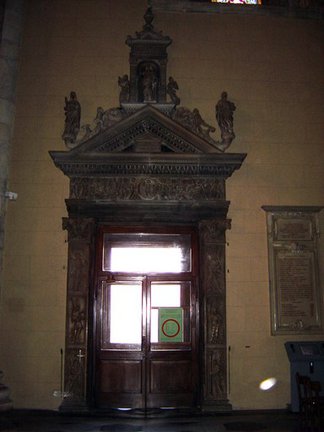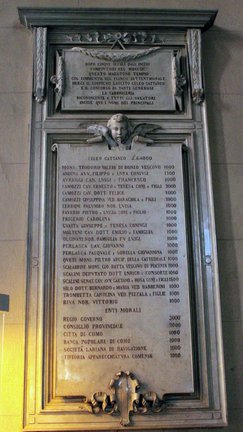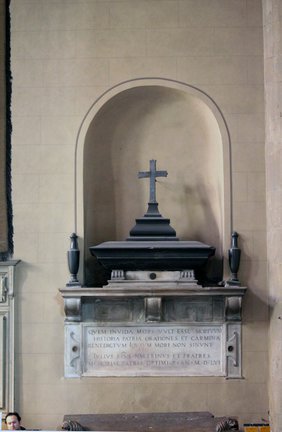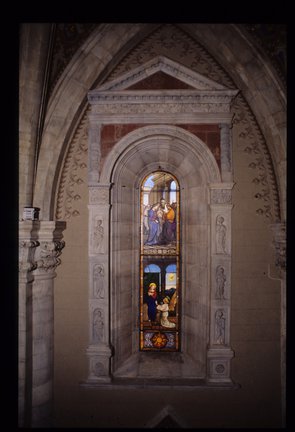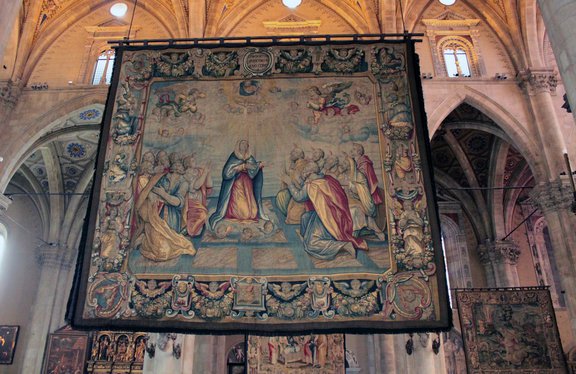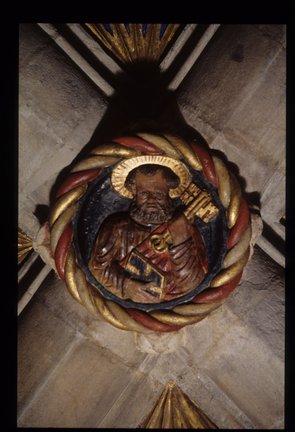Campata sinistra 3
La porta settentrionale è detta Porta della rana per un particolare scolpito all’esterno. È datata 1507 e decorata a rilievo anche all’interno dove si trovano le firme di Tommaso e Giacomo Rodari
Il portale interno presenta lungo le spalle angeli che reggono simboli della Passione. Sopra corre il fregio con il Trionfo di Gesù Bambino. Nel timpano triangolare è inscritto un sepolcro. Alla sommità svetta la statua di Cristo risorto. Scendiamo di nuovo sulle spalle del portale: fra motivi a candelabra sono scolpiti temi paganeggianti sui quali trionfa Gesù Bambino. Fra tutti il più singolare è quello del mostro con corpo parte di asino, parte di rettile.
La lapide a destra della porta ricorda il lascito di Celeo Cattaneo che consentì a fine ‘800 di completare le guglie del Duomo sul lato nord.
Il sarcofago del vescovo Giovanni de Advocatis morto nel 1293, proviene dalla cappella di S. Giovanni già in S. Maria Maggiore, la precedente cattedrale. Le immagini scolpite alludono al ruolo di vescovo e alla sua famiglia: i tre lucci, pesci tipici del Lago di Como, dichiarano che la famiglia era un ramo della famiglia Lucini, ma rievocano anche l’antico simbolo cristologico del pesce, insieme con l’agnello mistico.
Sopra sta il monumento di gusto umanistico a Benedetto Giovio, il primo storico di Como, fratello del più famoso Paolo Giovio. Gli fu dedicato dai familiari nel 1556.
La vetrata di Pompeo Bertini con Il riposo durante la fuga in Egitto, Disputa fra i dottori del tempio (1894) era un dono di Giovanni Perlasca.
L’arazzo con la Pentecoste offerto dal Consorzio dei Battilana di Como realizzato a Firenze da Guasparri Papini su cartone di Alessandro Allori nel 1595-1596.
La cornice della finestra presenta tre riquadri per spalla con motivi a candelabra, nello strombo formelle a fioroni.
Sul portale agli angoli del timpano stanno a sinistra Santa Apollonia con la tenaglia che le ha strappato il dente, a destra S. Pietro apostolo.
S. Apollonia e S. Pietro erano rispettivamente i titolari degli antichi altari nelle vicine cappelle.
S. Pietro apostolo è raffigurato anche nella chiave di volta con il libro e le chiavi.
All’antico altare di S. Pietro stava, fino al 1590, una piccola tavola dipinta, poi sostituita da una tela oggi nel Museo del Duomo. Si adattò lo stendardo rinascimentale con la Discesa dello Spirito Santo opera di Bartolomeo da Ponte Tresa ora nel Museo del Duomo.
